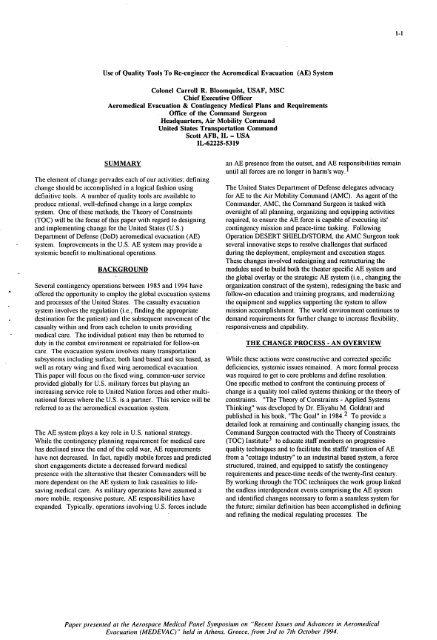Recent Issues and Advances in Aeromedical Evacuation (MEDEVAC)
Recent Issues and Advances in Aeromedical Evacuation (MEDEVAC)
Recent Issues and Advances in Aeromedical Evacuation (MEDEVAC)
Create successful ePaper yourself
Turn your PDF publications into a flip-book with our unique Google optimized e-Paper software.
-<br />
Use of Quality Tools To Re-eng<strong>in</strong>eer the <strong>Aeromedical</strong> <strong>Evacuation</strong> (AE) System<br />
Colonel Carroll R. Bloomquist, USAF, MSC<br />
Chief Executive Officer<br />
<strong>Aeromedical</strong> <strong>Evacuation</strong> & Cont<strong>in</strong>gency Medical Plans <strong>and</strong> Requirements<br />
Office of the Comm<strong>and</strong> Surgeon<br />
Headquarters, Air Mobility Comm<strong>and</strong><br />
United States Transportation Comm<strong>and</strong><br />
Scott AFB, IL - USA<br />
IL-62225-5319<br />
SUMMARY<br />
The element of change pervades each of our activities; def<strong>in</strong><strong>in</strong>g<br />
change should be accomplished <strong>in</strong> a logical fashion us<strong>in</strong>g<br />
def<strong>in</strong>itive tools. A number of quality tools are available to<br />
produce rational, well-def<strong>in</strong>ed change <strong>in</strong> a large complex<br />
system. One of these methods, the Theory of Constra<strong>in</strong>ts<br />
(TOC) will be the focus of this paper with regard to design<strong>in</strong>g<br />
<strong>and</strong> implement<strong>in</strong>g change for the United States (U.S.)<br />
Department of Defense @OD) aeromedical evacuation (AE)<br />
system. Improvements <strong>in</strong> the US. AE system may provide a<br />
systemic benefit to mult<strong>in</strong>ational operations.<br />
BACKGROUND<br />
Several cont<strong>in</strong>gency operations between 1985 <strong>and</strong> 1994 have<br />
offered the opportunity to employ the global evacuation systems<br />
<strong>and</strong> processes of the United States. The casualty evacuation<br />
system <strong>in</strong>volves the regulation (i.e., f<strong>in</strong>d<strong>in</strong>g the appropriate<br />
dest<strong>in</strong>ation for tlie patient) <strong>and</strong> the subsequent <strong>in</strong>ovement of tlie<br />
casualty with<strong>in</strong> <strong>and</strong> from each echelon to units provid<strong>in</strong>g<br />
niedical care. The <strong>in</strong>dividual patient may then be returned to<br />
duty <strong>in</strong> the combat environment or repatriated for follow-on<br />
care. The evacuation systeni <strong>in</strong>volves many transportation<br />
subsystems <strong>in</strong>clud<strong>in</strong>g surface, both l<strong>and</strong> based <strong>and</strong> sea based, as<br />
well as rotary w<strong>in</strong>g <strong>and</strong> fixed w<strong>in</strong>g aeromedical evacuation.<br />
This paper will focus on the fised w<strong>in</strong>g, common-user service<br />
provided globally for U.S. military forces but play<strong>in</strong>g an<br />
<strong>in</strong>creas<strong>in</strong>g service role to United Nation forces <strong>and</strong> other multi-<br />
national forces where the U.S. is a partner. This service will be<br />
referred to as the aeromedical evacuation system.<br />
The AE system plays a key role <strong>in</strong> U.S. national strategy.<br />
While the cont<strong>in</strong>gency plann<strong>in</strong>g requirement for medical care<br />
has decl<strong>in</strong>ed s<strong>in</strong>ce the end of the cold war, AE requirements<br />
have not decreased. In fact, rapidly mobile forces <strong>and</strong> predicted<br />
short engagements dictate a decreased forward medical<br />
presence with the alternative that theater Comm<strong>and</strong>ers will be<br />
niore dependent on the AE system to l<strong>in</strong>k casualties to life-<br />
sav<strong>in</strong>g medical care. As military operations have assunied a<br />
more mobile, responsive posture, AE responsibilities have<br />
exp<strong>and</strong>ed. Typically, operations <strong>in</strong>volv<strong>in</strong>g U.S. forces <strong>in</strong>clude<br />
an AE presence from the outset, <strong>and</strong> AE res onsibilities rema<strong>in</strong><br />
until all forces are no longer <strong>in</strong> harm's way. P<br />
The United States Department of Defense delegates advocacy<br />
for AE to the Air Mobility Comm<strong>and</strong> (AMC). As agent of the<br />
Comm<strong>and</strong>er, AMC, tlie Comm<strong>and</strong> Surgeon is tasked with<br />
oversight of all plann<strong>in</strong>g, organiz<strong>in</strong>g <strong>and</strong> equipp<strong>in</strong>g activities<br />
required, to ensure the AE force is capable of execut<strong>in</strong>g its'<br />
cont<strong>in</strong>gency mission <strong>and</strong> peace-time task<strong>in</strong>g. Follow<strong>in</strong>g<br />
Operation DESERT SHIELD/STORM, the AMC Surgeon took<br />
several <strong>in</strong>novative steps to resolve challenges that surfaced<br />
dur<strong>in</strong>g the deployment, employment <strong>and</strong> execution stages.<br />
These changes <strong>in</strong>volved redesign<strong>in</strong>g <strong>and</strong> restructur<strong>in</strong>g the<br />
modules used to build both the theater specific AE system <strong>and</strong><br />
the global overlay or the strategic AE system (i.e., chang<strong>in</strong>g the<br />
organization construct of the system), redesign<strong>in</strong>g the basic <strong>and</strong><br />
follow-on education <strong>and</strong> tra<strong>in</strong><strong>in</strong>g programs, <strong>and</strong> moderniz<strong>in</strong>g<br />
the equipment <strong>and</strong> supplies support<strong>in</strong>g the system to allow<br />
mission accomplishment. The world environment cont<strong>in</strong>ues to<br />
dem<strong>and</strong> requirements for further change to <strong>in</strong>crease flexibility,<br />
responsiveness <strong>and</strong> capability.<br />
THE CHANGE PROCESS - AN OVERVIEW<br />
While these actions were constructive <strong>and</strong> corrected specific<br />
deficiencies, systemic issues rema<strong>in</strong>ed. A more formal process<br />
was required to get to core problems <strong>and</strong> def<strong>in</strong>e resolution.<br />
One specific method to confront the cont<strong>in</strong>u<strong>in</strong>g process of<br />
change is a quality tool called systems th<strong>in</strong>k<strong>in</strong>g or the theory of<br />
constra<strong>in</strong>ts. "The Theory of Constra<strong>in</strong>ts - Applied Systems<br />
Th<strong>in</strong>k<strong>in</strong>g" was developed by Dr. Eliyahu M. Goldratt <strong>and</strong><br />
published <strong>in</strong> his book, "The Goal" <strong>in</strong> 1984.2 To provide a<br />
detailed look at rema<strong>in</strong><strong>in</strong>g <strong>and</strong> cont<strong>in</strong>ually chang<strong>in</strong>g issues, the<br />
Comm<strong>and</strong> Surgeon contracted with the Theory of Constra<strong>in</strong>ts<br />
(TOC) Institute3 to educate staff members on progressive<br />
quality techniques <strong>and</strong> to facilitate the staffs' transition of AE<br />
from a "cottage <strong>in</strong>dustry" to an <strong>in</strong>dustrial based system, a force<br />
structured, tra<strong>in</strong>ed, <strong>and</strong> equipped to satisfy the cont<strong>in</strong>gency<br />
requirements <strong>and</strong> peace-time needs of the twenty-first century.<br />
By work<strong>in</strong>g through the TOC techniques the work group l<strong>in</strong>ked<br />
the endless <strong>in</strong>terdependent events compris<strong>in</strong>g the AE system<br />
<strong>and</strong> identified changes necessary to form a seamless system for<br />
tlie future; similar def<strong>in</strong>ition has been accomplished <strong>in</strong> def<strong>in</strong><strong>in</strong>g<br />
<strong>and</strong> ref<strong>in</strong><strong>in</strong>g the medical regulat<strong>in</strong>g processes. The<br />
Paper presented at the Aerospace Medical Panel Symposium on "<strong>Recent</strong> <strong>Issues</strong> <strong>and</strong> <strong>Advances</strong> <strong>in</strong> <strong>Aeromedical</strong><br />
<strong>Evacuation</strong> (<strong>MEDEVAC</strong>)" held <strong>in</strong> Athens, Greece, from 3r.d to 7th October 1994.

















